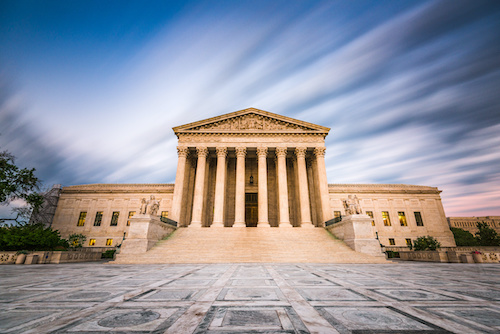“A trademark is a monopoly is what it is—it’s a state-granted patent, old-fashioned patent monopoly. And some things you’re just not allowed to monopolize.” – Justice Gorsuch
 The U.S. Supreme Court heard oral argument this morning in Vidal v. Elster, the latest in a line of recent cases probing the intersection of the First Amendment and trademark law, following 2017’s Matal v. Tam, 2019’s Iancu v. Brunetti, and this year’s Jack Daniel’s v. VIP Products. As in Tam and Brunetti, the Justices are being asked in Elster to review the constitutionality of a restriction on federal trademark registrations—this time, the prohibition under Section 1052(c) of the Lanham Act on the registration of living persons’ names without their consent, sometimes called the “Name Clause.”
The U.S. Supreme Court heard oral argument this morning in Vidal v. Elster, the latest in a line of recent cases probing the intersection of the First Amendment and trademark law, following 2017’s Matal v. Tam, 2019’s Iancu v. Brunetti, and this year’s Jack Daniel’s v. VIP Products. As in Tam and Brunetti, the Justices are being asked in Elster to review the constitutionality of a restriction on federal trademark registrations—this time, the prohibition under Section 1052(c) of the Lanham Act on the registration of living persons’ names without their consent, sometimes called the “Name Clause.”
But whereas the Court in Tam and Brunetti held that the Lanham Act’s restrictions on registration of scandalous, immoral, or disparaging marks violated the First Amendment, several of the Justices today suggested that the Name Clause does not implicate First Amendment concerns at all.
In 2018, Steve Elster applied to register TRUMP TOO SMALL for a variety of apparel goods in Class 25, including t-shirts. The trademark examiner refused registration because TRUMP TOO SMALL incorporates the name of President Donald Trump and Elster did not obtain Trump’s consent to register the mark, in violation of the Name Clause. Elster appealed the examiner’s refusal to the Trademark Trial and Appeal Board (TTAB), which upheld the refusal. In 2022, the Federal Circuit reversed the TTAB’s decision, holding that the Name Clause is unconstitutional as applied to TRUMP TOO SMALL because the Name Clause burdened Elster’s right to criticize a government official, which is at the core of the First Amendment. In effect, the Federal Circuit’s decision would require the U.S. Patent and Trademark Office (USPTO) to decide as to each individual trademark application whether refusal to register a mark would violate the First Amendment (e.g., in the case of the name of a public figure) or not (e.g., in the case of the name of a private individual).
The USPTO sought the Supreme Court’s review.
The Parties’ Core Arguments
For the USPTO, Deputy Solicitor General Malcolm Stewart argued that the Name Clause is not a restriction on speech but is better understood as a federal benefit. Elster’s inability to register the mark TRUMP TOO SMALL, he argued, in no way limits Elster’s freedom to use that mark on t-shirts or any other good—he simply cannot monopolize the mark and prevent others from also using it. Accordingly, Stewart argued, because the Name Clause does not burden Elster’s speech, it should be subject to rational basis review, which it passes.
For Steve Elster, Jonathan Taylor of Gupta Wessler argued that the Name Clause unconstitutionally burdens Elster’s right to engage in critical speech about President Trump. Because the USPTO withholds valuable benefits that are otherwise generally available, Taylor argued that the Name Clause should be subject to at least intermediate scrutiny, which it fails because the clause’s purpose (to prevent public figures from having “hurt feelings”) is wholly unrelated to trademark law’s purpose (preventing consumer confusion). Taylor emphasized that Elster brought the suit as an as-applied, rather than a facial challenge, to the Name Clause, so they would be “willing to give the government another crack at it in another case.”
Does the Name Clause Restrict Speech?
Taylor conceded that the Name Clause does not prevent Elster’s sale of goods bearing the slogan TRUMP TOO SMALL. But for Taylor, trademark registration is a valuable benefit, carrying legal protections such as a presumption of validity and incontestability.
Both sides agreed that—unlike the provisions at issue in Tam and Brunetti—the Name Clause is viewpoint-neutral, because the clause restricts registration of names regardless of whether the person is a public figure and regardless of whether the mark at issue is complimentary or critical. But for Taylor, that’s not the end of the inquiry. Taylor referred to the Name Clause as “speaker-based discrimination” because it permits an individual to register his or her own name but not another person’s name without that other person’s consent. This kind of speaker-based discrimination, he argued, “gives rise to viewpoint-based concerns” because individuals are highly unlikely to consent to registration of critical or disparaging marks.
Justice Jackson pressed Taylor for evidence that the Name Clause gives rise to viewpoint-based discrimination, which Taylor conceded that he did not have data to prove, but that it was a matter of “common sense.” Taylor also appealed to the Court’s decision in Jack Daniel’s, saying that “self-mockery with trademarks is quite an unusual thing,” meaning it would be rare for an individual to consent to a derogatory use of their name on a trademark.
Chief Justice Roberts and Justice Gorsuch expressed concern that striking down the Name Clause would undermine rather than promote First Amendment values. As Justice Gorsuch explained, “a trademark is a monopoly is what it is—it’s a state-granted patent, old-fashioned patent monopoly. And some things you’re just not allowed to monopolize.”
On the other hand, Justice Barrett raised a hypothetical about whether there would be a First Amendment problem if Donald Trump himself registered TRUMP TOO SMALL, preventing Elster from using it to criticize Trump. In this context, Elster would arguably have no alternative avenues for his expression, leaving him without a path to criticizing Trump in the manner of his choosing. In response, Stewart noted that Trump would need to use the mark in commerce and the mark would need to be perceived as a source-identifier—but if those conditions were met, there would be no First Amendment problem because Elster would merely be seeking to use TRUMP TOO SMALL as a source-identifier for competing goods.
Finding a Theory: Government Benefits Jurisprudence, Limited Public Forum Doctrine, History and Tradition, or Something Else?
In arguing to uphold the Name Clause, the USPTO relied primarily on the Supreme Court’s government benefits jurisprudence, arguing that the Court typically upholds criteria for distributing government benefits as long as those criteria are viewpoint-neutral.
Several of the Justices expressed strong reluctance to extend the Court’s government benefits jurisprudence to the trademark registration context. Justice Alito, for example, said that the government benefits jurisprudence “is a very difficult area of constitutional law and potentially quite a dangerous one.” Several of the Justices also agreed that trademark registration is “quite unlike a lot of government benefits,” in the words of Justice Gorsuch, because benefits cases typically relate to government provision of monetary subsidies. Justice Gorsuch expressed concern that applying the government benefit jurisprudence “might have ripple effects outside of intellectual property law.”
Justice Kagan saw some benefit to the government benefits cases. She emphasized that the cases stand for the conclusion that the government may grant a benefit to some and deny it to others, as long as the decision is not viewpoint-based. She recognized that those cases—which dealt primarily with monetary subsidies—are potentially distinguishable from trademark registration, but she knew of no cases where the Supreme Court held that the government is prohibited from declining to subsidize expressive activity based on non-viewpoint-based criteria. Taylor conceded that he was not aware of such a case.
Kavanaugh suggested that “if we’re looking at which box to put [the Name Clause] in in terms of First Amendment categories . . . it’s analogous or may be analogous to the Limited Public Forum Doctrine.” Stewart responded that Kavanaugh’s analogy works because the trademark registry operates as a sort of public forum provided by the government that is not essential for speakers—but Stewart hesitated to embrace the analogy because the principal register operates as a “warning potential infringers” rather than a “way of communicating to the public.” Justice Kagan suggested that the trademark registration program as a whole—not the register itself—could be seen as the “metaphorical forum.”
The prevailing sentiment among the Justices was that rigid categories like “government benefits” and the Limited Public Forum Doctrine” are unhelpful in this context. According to Justice Sotomayor, “it’s almost as if we’re becoming straightjacketed by labels instead of looking at this as I do from first principles.” For Sotomayor, “[t]he question is, is this an infringement on speech? And the answer is no.” The government merely needs a rational basis, she said, “and that these kinds of limitations have been historically accepted, [so] there’s certainly a rational basis.”
Gorsuch agreed that rigid categories are unhelpful but preferred a different approach: consulting history and tradition. Gorsuch leaned toward “focus[ing] instead on history and what that informs us about use of names in this context,” finding “a long historical tradition,” including in the common law, of content-based restrictions on trademarks, including restrictions on registering geographical and merely descriptive marks. This history, for Gorsuch, indicates there’s no First Amendment concern with the Name Clause. Justice Kavanaugh agreed with Gorsuch, telling Taylor that “the history here would suggest something like [the Name Clause] is appropriate.”
Is the Name Clause Necessary?
Taylor argued that the Name Clause is superfluous with the Lanham Act’s restrictions on registration of marks that are primarily a surname or that are likely to mislead.
In response, Stewart cited three purposes for the Name Clause that give a rational basis for Congress to have independently precluded registration of others’ names without consent:
*First, in deciding whether a mark would be viewed as primarily a surname and whether a mark would be misleading, the USPTO looks to the average consumer—but that reference point leaves some risk of consumer confusion among less-than-average consumers, which might still be a problem.
*Second, without the Name Clause, there is a risk that a person will lose control over use of their own name in commerce. Stewart raised the example of the DEREK JETER OF CAR DEALERS mark, which does not suggest affiliation with the baseball player Derek Jeter but rather functions like a superlative. As he explained, “next there will be the ‘Derek Jeter of Orthodontists’ and the ‘Derek Jeter of Barbers’ and the value of his name will be reduced, will be diluted.”
*Third is what Stewart referred to as the “true suggestion scenario.” Examples of a “true suggestion” would include the Los Angeles Lakers seeking to register the mark “Jack Nicholson’s favorite team,” the Chicago Bulls seeking to register “Barack Obama’s favorite team,” or a D.C. restaurant registering “Senator X Ate Here.” Each of these statements is true but potentially problematic for the public figures and is something Congress can reasonably prevent.
Implications for Copyright Law
Justices Thomas and Barrett inquired how a ruling in Elster would affect copyright law. Justice Barrett asked Stewart whether a prohibition on copyright registration for names without consent—for example, a book titled “Trump Too Small”—would be subject to rational basis review or heightened scrutiny. Stewart distinguished the hypothetical restriction in copyright law from the restriction in Section 1052(c) in light of the divergence in purposes and traditions between trademark law and copyright law. Whereas copyright law is aimed at fostering the free flow of ideas (the “engine of free expression,” as Stewart described it), trademark law is focused on fostering “the free flow of commerce.” Additionally, copyright law has no similar history and tradition of content-based restrictions as trademark law.
Justice Jackson suggested that a rationality analysis might come out differently for Name Clause provisions under copyright and trademark law. She explained that if the question is whether it’s reasonably related to purposes of the regime, the divergent purpose of copyright and trademark law could yield different answers even under rational basis review.
Although, on the surface, Elster presents similar issues to Tam and Brunetti, the argument made clear that the Supreme Court sees the Name Clause differently than it viewed the Lanham Act’s restrictions on immoral, scandalous, and disparaging marks. It’s relatively easy to predict the Court’s conclusion: that the Name Clause is a reasonable exercise of Congress’ authority to regulate commerce that does not unduly burden trademark applicants’ First Amendment rights. In other words, in the end, we all likely will be permitted to sell t-shirts emblazoned with TRUMP TOO SMALL on the front. But it’s far less clear what rationale—or, more than likely, multiple rationales—the Court will use to reach that conclusion.

![[IPWatchdog Logo]](https://ipwatchdog.com/wp-content/themes/IPWatchdog%20-%202023/assets/images/temp/logo-small@2x.png)



![[Advertisement]](https://ipwatchdog.com/wp-content/uploads/2024/04/UnitedLex-May-2-2024-sidebar-700x500-1.jpg)
![[Advertisement]](https://ipwatchdog.com/wp-content/uploads/2024/04/Artificial-Intelligence-2024-REPLAY-sidebar-700x500-corrected.jpg)
![[Advertisement]](https://ipwatchdog.com/wp-content/uploads/2024/04/Patent-Litigation-Masters-2024-sidebar-700x500-1.jpg)

![[Advertisement]](https://ipwatchdog.com/wp-content/uploads/2021/12/WEBINAR-336-x-280-px.png)
![[Advertisement]](https://ipwatchdog.com/wp-content/uploads/2021/12/2021-Patent-Practice-on-Demand-recorded-Feb-2021-336-x-280.jpg)
![[Advertisement]](https://ipwatchdog.com/wp-content/uploads/2021/12/Ad-4-The-Invent-Patent-System™.png)






Join the Discussion
No comments yet.